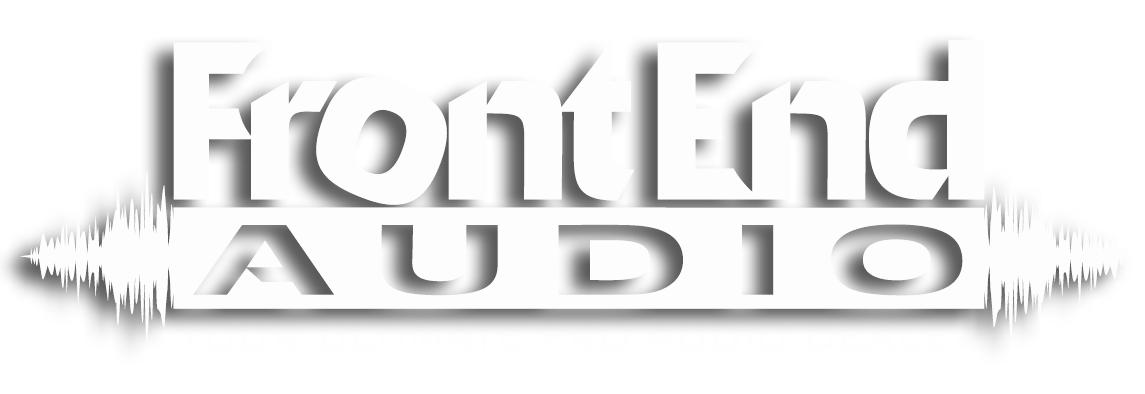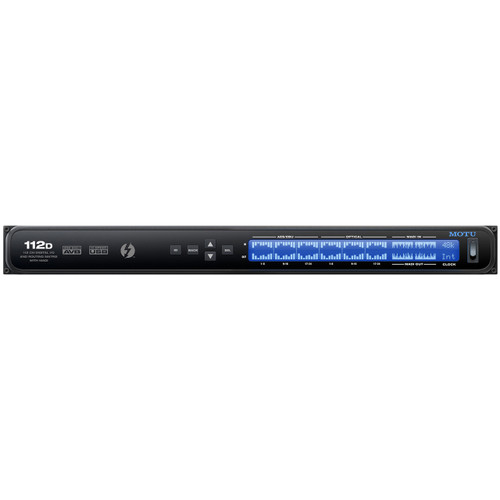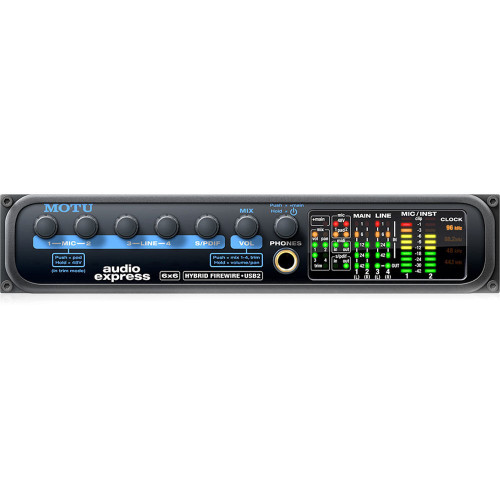The MOTU 112D Audio Interface is a digital audio interface, router, format converter, and stand-alone mixer offering 224 channels of simultaneous inputs and outputs with Thunderbolt, AVB Ethernet, and USB connectivity.
The audio interface serves as a flexible 64-channel MADI interface, router, and converter with low-latency and flexible routing/splitting to and from the AVB network, computer, AES/EBU, and optical formats. Three 8-channel D-sub connectors supply 24 channels of AES/EBU, while six banks of ADAT support up to 24 channels of optical I/O at 96 kHz.
Using Thunderbolt connectivity, the audio interface can stream 128 audio channels in and 128 channels out to the interface's physical outputs, the DSP-powered 48-channel mixer, or AVB audio network streams. The interface can also use high speed USB 2.0 (3.0 compatible) using class compliant drivers to work with most digital audio workstations.
The 48-channel digital mixer can mix physical inputs on the interface, audio channels from your host computer software, AVB audio network streams, or mixer outputs. It features seven stereo auxiliary busses, three groups, a reverb bus that can serve as an alternate 4th group, a main mix bus, and a separate monitor bus that can function as a solo buss.
The mixer includes 32-bit floating point precision DSP-powered models of three British analog console EQ profiles, a classic compressor module with optional peak/RMS operation, and a model of the legendary Teletronix LA-2A optical leveling amplifier with automatic gain control (AGC) characteristics. Each input channel strip features a high-pass filter, a gate, a four-band parametric EQ, and a compressor.
The device's digital routing matrix allows you to route any source signal including digital interface input, computer channel, mixer bus output, or network stream to any destination such as an interface output, host software input, mixer input, or any other device (or computer) on the AVB network. A single input or stereo pair can also be split and sent to multiple destinations.
This interface features an AVB Ethernet port that adopts the AVB industry networking standard for transporting high-bandwidth, low-latency audio and video over Ethernet. It was developed by the IEEE and enables connection to a second MOTU AVB audio interface (1248, 8M, or 16A) via a CAT-5E or CAT-6 Ethernet cable. The standard is open meaning it is not proprietary and will allow for open interoperability across different devices and brands.
The system can be further expanded through connection to a MOTU AVB Switch (sold separately), for five total devices and the capacity to stream over 512 channels on the network. Sixteen 8-channel network streams may be broadcast while simultaneously listening to sixteen 8-channel network streams. The AVB network provides its own network-wide time base for phase locking all connected devices and also allows one of the connected devices to be assigned as the master clock. An added benefit of the AVB network standard is the automatic device discovery for self-configuration, 100 meter cable runs, as well as the system's Stream Reservation Protocol which provides guaranteed Quality of Service (QoS) and an uninterrupted point-to-point network connection.
The audio interface's on-board DSP, mixing, device settings, and network audio routing can all be controlled through a web application running on a web browser from a laptop, tablet, or smartphone connected by wire or Wi-Fi to your local area network. This allows the interface to be controlled using Mac, Windows, Linux, iOS, and Android devices provided they share the same network. By connecting an Apple Airport or other Wi-Fi router directly to the interface with a standard Ethernet cable, the mixing and DSP controls of the interface can be managed using a smartphone or tablet, without the need for a computer. This is useful for situations such as mixing live sound. A total of up to 12 independent stereo mixes can all be independently controlled by different engineers or musicians via Wi-Fi connected iPhones or iPads.
The device includes a collection of quick setup presets designed for different applications in the studio, on stage, or for installed sound such as a recording interface or network snake. Presets can be customized using the digital routing matrix as well as saved for future recall.
MOTU 112D Audio Interface Features
- 112 simultaneous digital audio channels: 24 channels of AES/EBU I/O, plus 24 channels of ADAT optical I/O, plus 64 channels of MADI I/O, for 112 total channels digital audio I/O. All channels can be active simultaneously.
- 64 channels of MADI: Serves as a 64-channel MADI-to-AVB converter with near-zero latency and flexible routing and splitting to/from the AVB network.
- 24 channels of AES/EBU and ADAT up to 96 kHz: Three 8-channel (D-sub) banks of AES/EBU at all sample rates up to 96 kHz. Three 8-channel banks of ADAT optical at rates up to 48 kHz; six banks of ADAT at 2x sample rates (24 channels).
- Flexible routing, splitting and format conversion: Send any input to any output, or multiple outputs. Includes routing to and from the computer, plus any devices on the AVB network. Convert any format to any other.
- Universal connectivity: Connects to your computer with Thunderbolt technology, AVB Ethernet or audio class compliant high-speed USB 2.0 (compatible with USB 3.0 and iOS). Discovery app and web app software works alongside any host audio software.
- On-board 32-bit floating point DSP with large console style mixing and effects: Flexible 48-input digital mixer with 12 stereo busses and DSP effects, including reverb with sends, plus modeled analog EQ and compression, gate, and reverb.
- System expansion and audio networking: Add a 2nd MOTU AVB interface (1248, 8M, 16A, 24Ai, 24Ao or Monitor 8) with a simple CAT-5e ethernet cable. Connect up to five MOTU interfaces using a MOTU AVB Switch (sold separately). Build a network with multiple interfaces and computers using standard AVB switches and network cabling, with ultra-low network latency, even over long cable runs (hundreds of meters). Stream hundreds of audio channels among devices and computers on the network.
- Web app control: Control on-board DSP, mixing, device settings, and network audio routing from web app software running in your favorite browser on a laptop, tablet or smart phone connected by wire or Wi-Fi to your local area network.
- Stand-alone mixing with wireless control: Connect an Apple Airport™ or other Wi-Fi router directly to the 112D with a standard Ethernet cable and control the 112D's powerful routing, mixing and DSP effects from your smart phone or tablet, without a computer. Great for live sound mixing.
MOTU 112D Audio Interface Specifications
- Computer Connectivity: 1 x Thunderbolt, 1 x USB 2.0 Type B
- Digital Inputs: 6 x Optical (24 ch ADAT, 24 ch SMUX), 3 x DB-25 (AES/EBU In), 1 x BNC (MADI)
- Digital Outputs: 6 x Optical (24 ch ADAT, 24 ch SMUX), 3 x DB-25 (AES/EBU Out), 1 x BNC (MADI)
- Data I/O: Ethernet
- Clock I/O: In, Out/Thru














 Sign Up for exclusive sales and offers!
Sign Up for exclusive sales and offers!